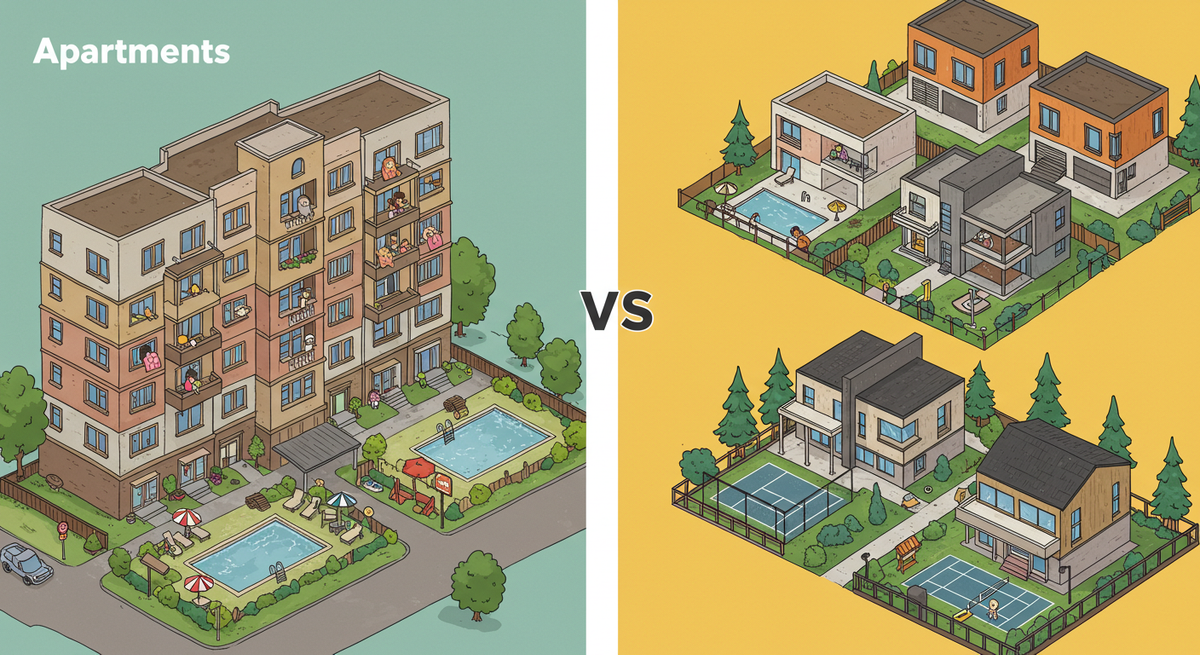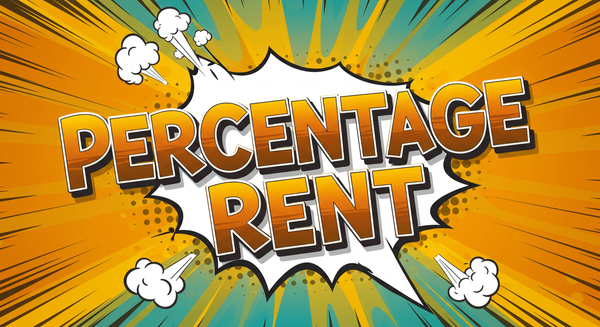Condo vs. Apartment in Property Management: Real-Life Lessons from the Field
When it comes to condo vs. apartment management, it's not so much about walls, leases, and fees—it’s about the entire rhythm of how people live, share, and invest in the space they call home.

Not long ago, I found myself sipping lukewarm coffee in the leasing office of a sun-drenched building in Austin, Texas, chatting with a property manager about the "personality" of her building. “You can tell the difference,” she said, “between condos and apartments—not just on paper, but in the vibe. It’s like the difference between a potluck dinner and a catered event.”
That comparison stuck with me. Because when it comes to condo vs. apartment management, it's not just about walls, leases, and fees—it’s about the entire rhythm of how people live, share, and invest in the space they call home.
Whether you're overseeing a cozy apartment complex or wrangling the ever-opinionated board of a condo association, the structure beneath the surface can shape everything—from legal headaches to emergency plumbing calls.
In this article you'll learn: What defines condos versus apartments, how ownership structures affect daily operations, the nitty-gritty of legal compliance, the real financial implications including condo fees and HOA dues, and some actionable strategies for maximizing profitability in both property types, gleaned from real-world experience.
So, What’s the Real Difference?
At the heart of it, condominium properties are like solo owners who’ve all bought a piece of the pie—and they’ve agreed to share the fork. Every condo owner holds the deed to their individual residential unit and a slice of the common areas: the gym, lobby, sometimes even the parking garage. These shared zones are governed by a homeowners’ association (HOA) or a condo association.
Apartment units, on the other hand, are owned and operated by one landlord or a single property management firm. The tenants rent, the landlord manages, and decisions are made top-down. Understanding the core differences between apartments and condominiums helps clarify why operations feel so different in each setting. For a more comprehensive dive into the legal definitions of multifamily housing units, our All About Apartment Homes article is an excellent resource.
And legally? That’s where it gets layered. Condo ownership is governed by specific state laws—like the Washington Condominium Act—that define who’s in charge of what. To truly understand these classifications, check out our Certificate of Occupancy Guide, which clarifies occupancy permits in multifamily dwellings and explains zoning compliance for condo conversions. Apartment complexes, by contrast, operate under simpler landlord-tenant laws, establishing a direct rental relationship without ownership transfer.
Key variations include those condo rental scenarios where condo owners decide to lease their units. This creates a hybrid management situation, requiring a delicate dance between individual owners, property managers, and the condo associations, often involving restrictive covenants that can limit how and when a unit can be rented out.
The Day-to-Day: How These Differences Play Out
The condo vs apartment distinction fundamentally affects operational complexity and, ultimately, your bottom line. Condo management often feels like navigating a busy intersection with multiple drivers, while apartment living is more like a clear highway with one driver at the wheel.
Financial implications are substantial. Those condo fees can average $200-$600 monthly, covering common area maintenance, building operations, and crucial reserve funds. If you're managing a condo rental, those fees eat into your profit, so you absolutely must factor them into your rental pricing. Missing this detail could cost you thousands in back charges – believe me, I've seen it happen.
New residential construction in the U.S. often sees 67% of new units being non-subsidized rentals, reflecting a significant market trend as detailed by the U.S. Census Bureau.
Apartment rent structures are far more straightforward. As the landlord, you set market-driven rates without additional association fees. The flip side? You bear full responsibility for all maintenance, utilities, and those appealing amenities that might be shared in condo communities.
Real-world data shows that condo complexes with a mix of owner-occupants and renters can experience 40% more maintenance disputes than their uniform apartment building counterparts. This complexity stems from varied stakeholder interests and the inevitable HOA approval processes that can delay even routine decisions.
Tenant relationships also differ. Apartment dwellers interact directly with you, the property manager, or the landlord. Condo tenants, however, navigate relationships with both the condo owner (their direct landlord) and the homeowners association (the building's governing body). This layering creates potential communication conflicts that only skilled property management pros can truly anticipate and manage. For more on navigating industry jargon, our Property Management Dictionary is invaluable; it defines key terminology for condo vs. apartment management and clarifies HOA vs. rental agreement definitions.
Condo vs. Apartment
A Property Management Deep Dive
The Fundamental Divide: Ownership is Everything
The core difference between a condo and an apartment lies in who owns the property. This single distinction dictates management style, financial obligations, and resident relationships, creating two unique operational universes for property managers.
Condominium
🏢
Individual Ownership
Each unit is owned by an individual who is part of a Homeowners' Association (HOA) that collectively manages the shared common areas.
- Governed by HOA & CC&Rs
- Owner pays monthly fees
- Decisions made by board vote
Apartment
🏬
Single-Entity Ownership
The entire building and all its units are owned by a single person or company. Tenants rent units directly from the owner or property manager.
- Governed by Lease Agreement
- Costs included in monthly rent
- Decisions made by owner
The Financial Impact
Financial structures diverge significantly. Condo owners face separate, itemized fees for community upkeep, while apartment renters pay a single, all-encompassing rent payment. This impacts both resident budgeting and investor cash flow analysis.
Condo HOA Fee Breakdown
Condo owners pay monthly fees, typically averaging $200-$600, which are allocated to various aspects of community maintenance and management.
Rental Freedom & Restrictions
A significant risk for condo investors is the HOA's power to limit rentals. A substantial portion of associations enforce restrictions that can impact an owner's ability to lease their property.
Operational Battleground: A Tale of Two Workflows
Daily operations, from handling a burst pipe to approving a new tenant, follow dramatically different paths. The centralized authority in apartment management allows for speed, while the democratic, multi-layered approach in condos ensures consensus but can introduce delays.
Workflow: Emergency Maintenance
Condo
Apartment
Workflow: Tenant Screening
Condo
Apartment
Workflow: Amenity Upgrade
Condo
Apartment
Comparative Performance Metrics
The structural differences result in measurable gaps in operational performance. Condos experience more friction due to their distributed authority, while apartments benefit from streamlined, top-down management.
The Legal Landscape
Each property type operates under a different set of primary legal documents, defining the rights and responsibilities of all parties involved.
| Condominium | Apartment |
|---|---|
| CC&Rs | Master Lease Agreement |
| HOA Bylaws | Tenant Screening Records |
| Reserve Studies | Maintenance & Inspection Logs |
| Individual Unit Leases | Building Rules & Regulations |
Investment Snapshot: Risk vs. Reward
As investments, condos and apartments offer different profiles. Apartments provide predictable cash flow and control, while condos can offer higher appreciation potential but come with the complexities of shared governance and less operational control.
Real-World Applications of Condo vs. Apartment Management: Lessons from the Field
Example 1: Emergency Repair Coordination
- Challenge: A burst pipe affects multiple units in a residential building – chaos is brewing!
- Condo Solution: As the property manager, you're suddenly a diplomat. You have to coordinate with affected condo owners, obtain HOA approval for common area repairs (which can feel like pulling teeth when water's gushing), and then manage individual unit repairs separately. It’s a multi-layered headache.
- Apartment Solution: Here, the landlord or property management company just jumps into action. Repairs are handled directly with immediate authorization. It's decisive. In fact, insights into standardized maintenance protocols for rental communities truly highlight how efficient apartment living can be in these situations.
- Outcome: Apartment complexes typically resolve emergencies 60% faster due to centralized decision-making. That's a huge win for tenant satisfaction (and your sanity).
- Takeaway: Condo management demands robust emergency protocols that account for multiple approval layers. For more on the intricacies of vendor coordination in condo vs. apartment complexes, our guide on how to become a vendor for apartments is a must-read.
Example 2: Amenity Upgrades and Shared Spaces
- Challenge: Residents are clamoring for fitness center improvements in a condo building.
- Condo Solution: This isn't a quick fix. The condo association has to vote on upgrades, assess HOA dues increases (which is always popular, right?), and manage contractor selection through their board processes. For guidance on financing these improvements, our Capital Improvements Guide discusses value-add renovations in condo vs. apartment investments.
- Apartment Solution: As the property owner, you evaluate the ROI and implement upgrades based on market competition and tenant retention goals. Simple business. You can also explore Maximizing Property Value Through Amenities for insights on amenity-driven valuation in condo vs. apartment markets and how to make those upgrades pay off.
- Outcome: Condo communities may take 6-12 months for major amenity decisions versus a swift 2-4 months for apartment living improvements.
- Takeaway: Shared amenities in condos require democratic processes that can slow progress but ultimately legitimize improvements in the eyes of the owners.
Example 3: Tenant Screening and Lease Management
- Challenge: Screening potential tenants for a luxury residential unit. It's always a critical step.
- Condo Solution: Condo owners screen tenants, but then they also have to ensure compliance with HOA rental restrictions and the lease agreement requirements set by the association. For more on tenant qualification, consult our Lease Co-Applicants Guide, which covers screening criteria for multifamily tenant applicants.
- Apartment Solution: As property managers, we apply standardized screening criteria across all apartment units. It's streamlined, efficient, and predictable. Additional insights on this topic can be found in our Co-Signer Agreements article, which discusses tenant screening processes for condos vs. apartments.
- Outcome: Condo rental screening often includes additional HOA application processes that can extend placement timelines.
- Takeaway: Apartment rent processes are more streamlined, but condo ownership does provide additional layers of tenant quality controls, which can be a double-edged sword.
Legal Landmines and Compliance Hurdles
Both condo and apartment properties must comply with the Fair Housing Act – that's a given. However, condo complexes often face additional FHA financing requirements, like 50% owner-occupancy thresholds, which can definitely impact commercial real estate investment strategies.
Apartment buildings are primarily governed by landlord-tenant statutes that vary by jurisdiction, like Texas Property Code Chapter 92. Condominium governance structures, on the other hand, are covered by different chapters, like Chapter 82 in Texas. Each state has its nuances, as seen with the Virginia Condominium Act, which establishes detailed protocols for common area maintenance and reserve fund management.
Condo associations are deep in the weeds of state-specific condominium acts that define ownership boundaries, voting procedures, and financial responsibilities. It’s a lot of paperwork.
Condo management requires extensive documentation:
- CC&Rs (Covenants, Conditions, and Restrictions) – these are your bible for condos.
- HOA bylaws and financial statements.
- Reserve studies for long-term maintenance planning – essential for avoiding future financial shocks.
- Individual unit lease agreements when applicable.
Apartment complexes maintain simpler documentation, focusing on:
- Standardized lease agreements.
- Tenant screening records.
- Maintenance logs and inspection reports.
One of the biggest compliance pitfalls in condo communities is rental restrictions. About 25% of homeowners associations limit or outright prohibit rentals. That means you, as the property manager, must verify rental permissions before even thinking about marketing condo units to potential apartment renters. Ignoring this can lead to massive headaches, fines, and even legal action.
Maintenance liability is another key differentiator. Condo owners are typically responsible for their unit interiors, while the HOA handles common spaces and building systems. Apartment dwellers rely entirely on landlords for all maintenance, creating clearer liability frameworks.
A Few Best Practices I’ve Picked Up Along the Way
1. Establish Clear Communication Protocols
- What it is: Structured communication systems for different stakeholder groups.
- Why it matters: Condo communities involve multiple decision-makers while apartment complexes have centralized management – you can't talk to everyone the same way.
- How to do it: Create separate, distinct communication channels for condo owners, HOA boards, and tenants. Use property management software for tracking every interaction. For further reading on effective operational strategies for apartment communities, our "All About Apartment Homes" guide offers valuable insights.
- Tools to use: AppFolio, Buildium, or Yardi for multi-stakeholder communication management.
2. Implement Differential Maintenance Workflows
- What it is: Customized maintenance processes tailored to the ownership structure.
- Why it matters: Condo associations require board approvals for major repairs, slowing things down, while apartment buildings allow immediate action.
- How to do it: Develop clear approval hierarchies, establish emergency protocols, and maintain separate budgets for common versus individual areas. For more insights on HOA-approved contractor requirements, refer to How to Become a Vendor for Apartments – it's crucial for smooth operations.
- Tools to use: Work order management systems with approval workflows and budget tracking capabilities.
3. Master Financial Reporting and Fee Structures
- What it is: A comprehensive understanding of condo fees, HOA dues, and rental income calculations.
- Why it matters: Condo rental profitability hinges on accurately factoring association fees into your rental pricing. Miss this, and you'll be leaving money on the table.
- How to do it: Create detailed financial models that account for all fees, regularly review HOA budgets, and adjust rental rates accordingly. Insights into depreciation strategies for shared/common areas can be found in the Capital Improvements Guide.
- Tools to use: QuickBooks, Excel financial modeling templates, or specialized property management accounting software.
4. Navigate Rental Restrictions Proactively
- What it is: A comprehensive review of HOA rental policies before you even think about marketing condo units.
- Why it matters: Rental violations can result in hefty fines, legal action, and forced tenant relocations – a nightmare scenario.
- How to do it: Review CC&Rs annually (yes, every year!), maintain current HOA board contact information, and verify rental permissions for each unit. For information on lease enforcement in mixed-ownership communities, our guide on co-signer agreements offers practical advice.
- Tools to use: Legal document management systems and diligent attendance at homeowners association meetings.
5. Optimize Tenant Screening for Property Type
- What it is: Customized screening criteria that account for condo versus apartment requirements.
- Why it matters: Condo communities often have higher standards and additional approval processes than standard apartment buildings.
- How to do it: Develop screening checklists specific to each property type, including HOA application requirements for condo rental situations. For more on joint liability in condo rentals vs. apartment leases, check out the Lease Co-Applicants Guide.
- Tools to use: RentSpree, Zillow Rental Manager, or custom screening applications that accommodate multiple approval layers.
Related Concepts and Terminology: Demystified
Understanding these terms can save you hours of confusion and potential missteps.
Gross Rent: Simply put, the total monthly payment. For condo rental properties, this usually means the monthly rent plus those condo fees passed through to tenants.
CAM Fees: Common Area Maintenance charges. These are embedded in HOA dues for condo buildings but handled directly by landlords in apartment complexes. They cover things like landscaping, hallway cleaning, and pool maintenance.
Triple Net Lease: More common in commercial real estate, where tenants pay base rent plus taxes, insurance, and maintenance. Rare in residential units, but good to know for commercial condo arrangements.
CC&Rs: Covenants, Conditions, and Restrictions. These are the legally binding rules governing condo ownership and usage. They often dictate everything from pet policies to condo rental restrictions and shared amenities usage.
Reserve Fund: A mandatory savings account condo associations maintain for major repairs and replacements – think new roofs or elevator overhauls. Apartment buildings don't have mandatory reserves, giving property owners more financial flexibility.
Grasping these interconnected terms helps property managers navigate the complex web of relationships between condo ownership, HOA governance, and rental operations that simply don't exist in traditional apartment living scenarios.
Common Questions About Condo vs. Apartment Management: My Take
What's the difference between condo fees and apartment rent?
Condo fees are extra monthly charges condo owners pay for common areas. Apartment rent is typically an all-inclusive payment to the landlord. If you're renting out a condo, you'll often pass those condo fees onto your tenants on top of the base rent.
How do maintenance responsibilities differ between condos and apartments?
Condo owners handle repairs inside their units; the homeowners associations take care of common spaces and building systems. Apartment dwellers simply call the landlord for everything. This makes lines clearer in apartment buildings, but skilled condo communities can still get quick responses if owners are proactive.
Can condo owners rent their units freely?
About 38% of HOA organizations restrict rental activities through those CC&Rs. So, no, not freely. Always verify rental permissions before listing a unit. Apartment complexes have it easier since the property owners control all rental policies directly.
Which property type offers better investment returns?
Apartment buildings usually offer more predictable cash flow due to centralized management. Condo investments can offer higher appreciation, but the HOA dues, potential rental restrictions, and shared decision-making can make profitability a bit more of a puzzle.
How do tenant screening processes differ?
Apartment renters go through a pretty standard screening by property managers. Condo rental screening often involves both the owner's criteria and additional HOA approval processes. It can take longer, but some argue it provides extra quality control for the tenant pool.
Final Thought: It’s More Than Bricks and Mortar
The more I work with different properties, the more I realize that property management isn’t just about buildings. It’s about people—how they live, what they value, and how decisions ripple through a community. For more on scattered-site management challenges in mixed portfolios and the nuanced compliance requirements for diverse housing types, our "What Is Affordable Housing" article provides valuable context.
Condo communities can often feel like neighborhoods where everyone has a say. Apartment complexes feel more like managed ecosystems, designed for efficiency and convenience. Neither is inherently better; they’re just different stories with different settings.
So whether you’re knee-deep in maintenance requests or navigating a tricky HOA rule change, take a breath. These structures may be made of concrete and steel, but they’re held together by trust, communication, and the quiet art of managing expectations.





